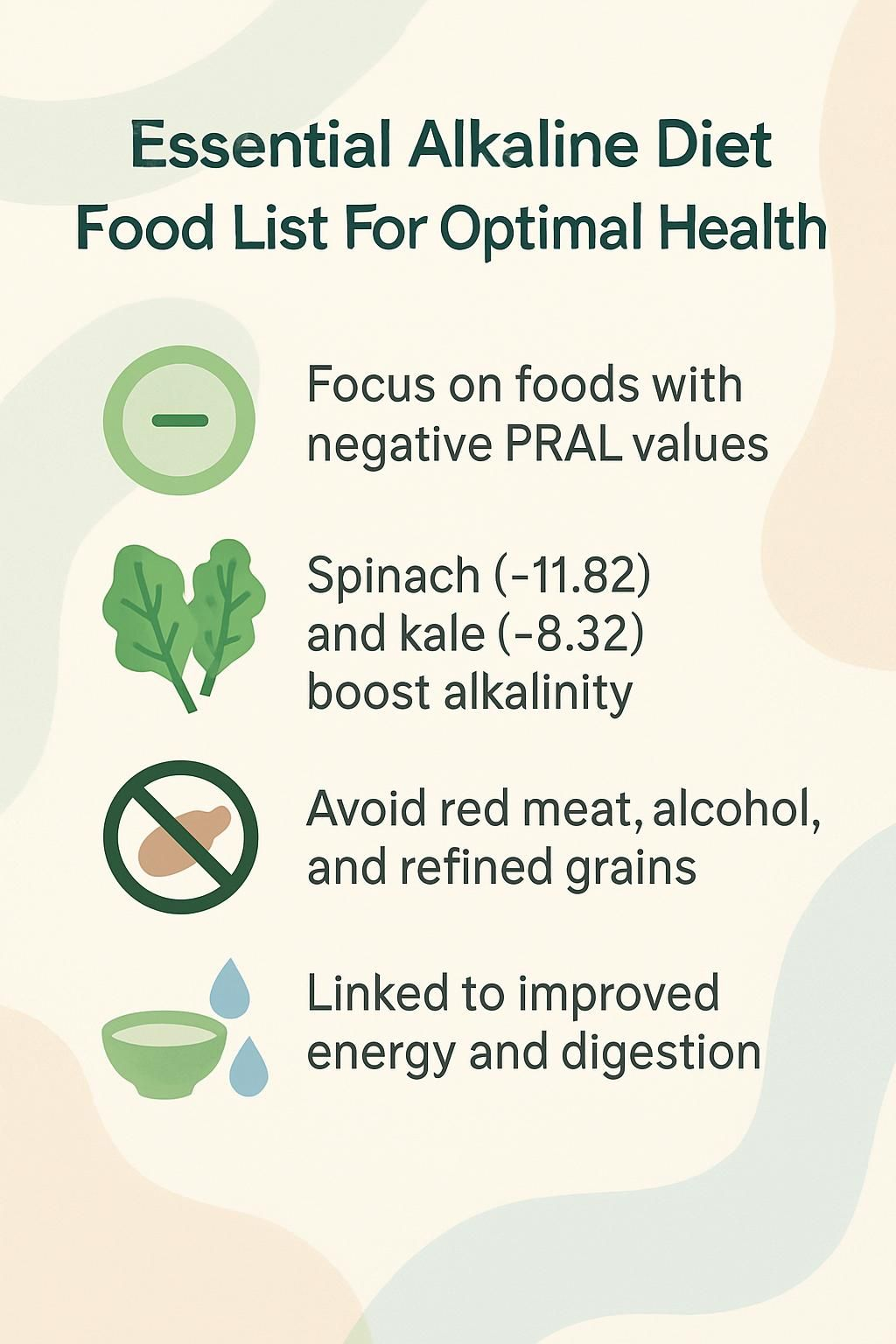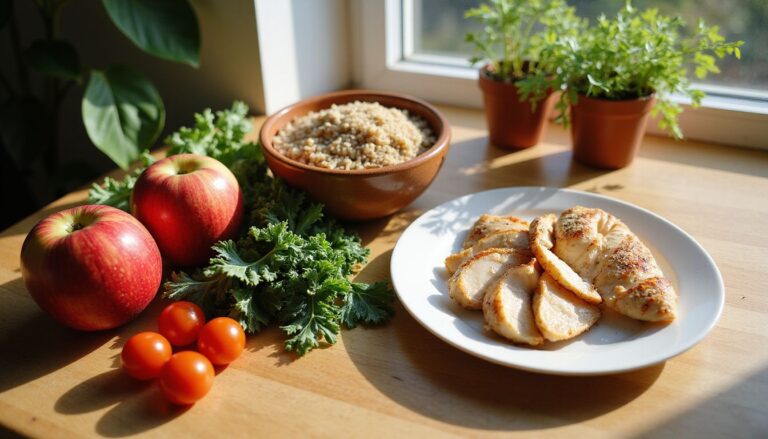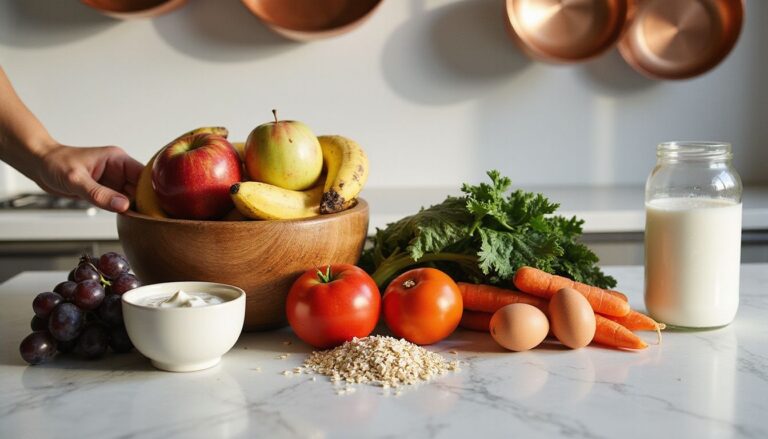Essential Alkaline Diet Food List For Optimal Health
Our Nutrition Assistant AI Suite will transform your body. You will lose fat, get toned, and build muscle. Gain confidence and optimal health.
Many people feel unsure which foods truly support better health or worry their meals are too acidic. I felt the same. While sorting through research on the alkaline diet, I learned that popular choices like broccoli, avocados, and kale often appear on any trusted alkaline food list because they deliver key nutrients.
After reviewing data on alkaline diet foods, I built a simple guide to help you choose nutrient-rich picks for a balanced diet plan. Use this clear list to find easy ways to improve daily choices and feel more in control.
Key Takeaways
- The alkaline diet centers on fruits, vegetables, nuts, seeds, and legumes with negative PRAL scores, a measure called Potential Renal Acid Load, to lower dietary acid load.
- Foods often cited include spinach, PRAL about -11.82, kale, about -8.32, sweet potato, about -5.62, apples, about -1.92, and avocado, about -2.41, based on USDA data and Remer et al., 2003.
- Reviews in Nutrients, 2018, and recent systematic reviews from 2021 to 2023 link plant-forward eating with higher energy, better digestion, and lower risk factors for heart disease and diabetes.
- Limit highly acidic foods such as processed snacks, red meat, dairy, eggs, alcohol, sugary sodas, refined grains, and heavy caffeine drinks.
- The alkaline diet does not change blood pH, which stays near 7.35 to 7.45. It can still support healthy habits and nutrient density with routine medical guidance.

Understanding the Alkaline Diet Basics

I want to help you see how the alkaline diet fits into a healthy eating plan. A few basics make it easier to spot foods that support better balance in the body.
What Are Alkalinity and Acidity?
The pH scale runs from 0 to 14 and shows how acidic or alkaline something is. Acidic is 0 to 6, neutral is 7, and 8 to 14 is alkaline.
Your blood pH must stay between about 7.35 and 7.45 for normal function. This is slightly alkaline and tightly controlled.
Foods affect acidity after digestion based on the minerals they leave behind, sometimes called ash. Animal protein and many processed foods tend to be acid-forming. Fruits and vegetables high in potassium, magnesium, or calcium tend to be alkalizing.
Scientists estimate this effect with PRAL, Potential Renal Acid Load. Negative PRAL numbers suggest a stronger alkalizing impact on urine, not on blood.
“Eating more fruits and vegetables can help shift urinary pH above seven,” a registered dietitian at a cancer center once told me while I was making changes to my diet.
How Does the Alkaline Diet Work?
An alkaline-style plan favors fruits, vegetables, legumes, nuts, and seeds. These foods often score as alkaline-forming. Foods like red meat, dairy, eggs, processed snacks, and alcohol are more acidic.
Some people use urine dipsticks to track changes. Urine pH can move with diet. Blood pH does not, since your lungs and kidneys regulate it.
Older ideas such as the acid-ash hypothesis linked acid-forming diets to bone loss. Newer studies do not support strong links to osteoporosis or clear cancer prevention. The bigger win is simple. Eating more whole plant foods improves fiber, vitamins, and hydration while easing saturated fat intake.
Next, I explain how potential benefits show up in day-to-day energy.
What Are the Health Benefits of the Alkaline Diet?
I noticed that a plant-forward, alkaline-style diet may support steady energy and overall wellness. Research suggests that eating more alkaline-forming foods can help lower certain risk factors and improve quality of life.
How Can It Boost Energy Levels?
Cutting added sugars and packaged snacks helped me avoid afternoon crashes. Fresh, nutrient-dense options like spinach, kale, and apples supply slow, steady fuel.
A 2018 review in Nutrients found that higher fruit and vegetable intake often links with less fatigue. More magnesium and vitamin C in these foods also support energy metabolism.
Stable blood sugar comes from replacing refined carbs with whole foods. This simple swap helps me stay focused longer.
Plant-based, alkaline-forming foods help me support natural energy without leaning on caffeine.
How Does It Improve Digestion?
Fiber from fruits, vegetables, legumes, and seeds supports regularity. Apples, beans, and leafy greens help my digestion and reduce bloat.
Processed foods often lack fiber and can slow digestion. Studies link higher plant intake with better gut health and a more diverse microbiome, the helpful bacteria in the gut.
Choosing whole foods helps with nutrient absorption and may lower common digestive complaints, including heartburn.
Can It Lower Risks of Chronic Diseases?
Eating more fruits and vegetables while limiting sodium, sugar, and saturated fat supports heart health. Plant-based patterns are tied to lower blood pressure and improved cholesterol.
Research suggests that plant-focused diets help reduce risk factors for chronic disease. A 2019 review found these patterns can help prevent some conditions linked to lifestyle.
Evidence for cancer prevention from an alkaline diet alone is limited. Still, nutrient-dense meals rich in antioxidants support long-term wellness as part of a balanced approach.
How Does It Support Bone Strength?
Many people want stronger bones. Early theories put the blame on acid-forming foods. Recent reviews do not support the idea that normal high-protein diets harm bone density.
An alkaline-style plan, rich in potassium, magnesium, and vitamin C, may aid calcium balance. Leafy greens, almonds, and tofu supply minerals and building blocks that bones need.
I fill my plate with kale, spinach, almonds, and tofu. That pattern supports bone health through nutrients, not by chasing pH changes.
Key Principles to Follow on the Alkaline Diet
I stick with a few simple rules. They make this diet easier to follow and more helpful for weight and wellness.
Why Prioritize Plant-Based Foods?
Mostly plant-based eating helps lower dietary acid load. Vegetables and fruits like kale, spinach, cucumber, and apples provide minerals that support an alkalizing effect.
Several systematic reviews link plant-forward diets to lower risks of chronic disease. I also feel more steady energy when I lean on legumes, nuts, and whole grains like quinoa.
Choosing whole and unprocessed foods makes me feel healthier throughout the day.
Which Processed and Acidic Foods Should Be Limited?
Focusing on plants works best when I also reduce acidic, processed items. Here are common foods I limit:
- Processed snacks like chips, cookies, and candy are high in sugar and unhealthy fats, which add calories without key nutrients.
- Alcoholic drinks raise acid load and dehydrate the body, which can work against weight goals.
- Red meats such as beef and bacon are acidic and tied to higher risks for several chronic conditions.
- Dairy products, including cheese and milk, raise acid load and add saturated fat.
- Eggs have an acid-forming effect, so I reduce them on a strict alkaline plan.
- Most white breads and refined grains act like sugar and raise acidity. I choose whole or sprouted grains instead.
- Sugary sodas and sports drinks raise blood sugar and dietary acid load.
- Heavy caffeine can affect hydration. Water or herbal tea is a better daily choice.
Cutting these foods supports digestion and steadier energy while I shop from an alkaline grocery list.
How to Balance Your Body’s pH Level?
Limiting processed foods sets the stage. I then choose more negative-PRAL foods to encourage an alkalizing effect after digestion.
Spinach, kale, asparagus, cucumber, and beets supply potassium and magnesium, two helpful minerals. Alkaline water can shift urine pH, but blood pH stays tightly controlled near 7.4.
As I added leafy greens and reduced red meat and sweets, my daily energy improved. A focus on mineral-rich plants supports the body’s natural balance, backed by recent systematic reviews.
Essential Foods to Include in an Alkaline Diet
Choosing the right foods builds a strong base. I keep a simple alkaline diet food list within reach when planning meals.
What Vegetables Are Recommended?
Non-starchy vegetables are the core of this plan. They deliver fiber, minerals, and plant compounds that support health and a lower dietary acid load.
- Broccoli, PRAL about -4.02. One cup cooked supplies 5 g fiber and 10 percent Daily Value for potassium. I steam it for salads or stir-fries.
- Beets, PRAL about -5.4 raw and -2.8 cooked. They are rich in helpful plant pigments. I roast slices with olive oil.
- Carrots, PRAL about -5.72. They provide beta-carotene and lutein for healthy vision.
- Kale, PRAL about -8.32. It is rich in vitamins A, C, and K and supports bones.
- Spinach, PRAL about -11.82. It is highly alkalizing and provides iron, potassium, and antioxidants.
- Mustard greens, PRAL about -3.21. They add fiber and vitamin K for normal cell function.
- Sweet potato, PRAL about -5.62. It offers carotenoids, vitamins A and C, potassium, and fiber.
Adding these vegetables often can help replace processed options and reduce dietary acid load that rises with heavy animal products.
Data adapted from USDA FoodData Central and Thomas Remer et al., “Potential renal acid load,” American Journal of Clinical Nutrition, 2003.
Why Include Kale?
Kale earns a place on every alkaline diet food list. With a PRAL near -8.32, it supports an alkalizing pattern and supplies vitamins A, C, and K.
Studies link regular kale intake with better weight control markers and heart health. One cup adds helpful fiber that supports fullness and digestion.
Kale also provides minerals important for bones. I add it to salads, soups, and sautés to boost nutrients while I reduce acidic options like red meat and processed snacks.
Next up, does spinach fit the alkaline diet?
Is Spinach Good for the Alkaline Diet?
Spinach is one of the most alkalizing vegetables with a PRAL near -11.82. It offers vitamins A, C, and K plus folate and magnesium.
This nutrient density helps lower acid load and supports heart and bone health. I reach for fresh spinach for quick smoothies or salads.
Next, see why broccoli also helps maintain an alkaline-friendly plate.
How Does Broccoli Help?
Broccoli’s PRAL is about -4.02, so it is alkaline-forming. One cup cooked delivers 5 grams of fiber and helpful potassium.
Fiber supports gut health and regularity. Antioxidants in broccoli help protect cells from everyday stress.
I add it to stir-fries and pasta bowls to keep meals plant-forward and satisfying.
What Are the Benefits of Cucumber?
Cucumber makes my salads crisp and hydrating. It is about 95 percent water and very low in calories.
One cup sliced has roughly 16 calories. It helps me meet hydration goals, which supports digestion and comfort, especially in warm weather.
Next, here is why sweet potato deserves a spot on your list.
Should You Eat Sweet Potato?
Sweet potatoes offer a different nutrient mix and a PRAL near -5.62. They provide vitamin A, vitamin C, potassium, and fiber.
These nutrients support eye health and immune function. I swapped white potatoes for sweet potatoes several times a week and noticed steadier energy.
They bake or steam well and add natural sweetness without added sugar. Negative-PRAL foods like this can support an alkaline-style plan.
Which Fruits Support an Alkaline Diet?
Fruits add flavor, fiber, and hydration. Many are mildly alkalizing and easy to enjoy daily.
- Apples, PRAL about -1.92, add fiber, antioxidants, and vitamin C.
- Avocados supply healthy fats and fiber and support an alkaline pattern.
- Oranges, PRAL about -3.62, provide high vitamin C for immune support.
- Bananas, PRAL about -6.92, deliver potassium and slow-digesting carbs for steady energy.
- Dates, PRAL about -13.72, pack potassium and work well in small portions for snacks.
- Watermelon hydrates and provides antioxidants with light sweetness.
- Raspberries offer fiber and vitamin C from a low-calorie fruit.
Eating a variety of fruits helps manage acid load and supports digestion and energy across the day.
Why Eat Avocado?
Avocado has a PRAL near -2.41 and supports an alkaline-friendly pattern. It provides heart-healthy fats, fiber, potassium, magnesium, and vitamin E.
I add avocado to salads and grain bowls for a creamy texture that keeps me full. Research links avocado with better heart markers and improved satiety.
It also fills mineral gaps when cutting back on animal foods.
Are Lemons Alkaline?
Lemons taste sour, but after digestion they act as an alkalizing food. Their acids break down and leave alkaline byproducts.
Lemons also supply vitamin C and antioxidants. I squeeze lemon into water or salads for flavor and a simple routine I can keep.
How Do Apples Fit In?
Apples bring fiber, vitamin C, and protective plant compounds. With a PRAL around -1.92, they have a mild alkalizing effect.
I snack on apples or slice them into salads. Foods high in fiber can support gut health and reduce cravings for sweets.
Fresh fruit also helps me skip processed desserts while staying on plan.
What Makes Berries Beneficial?
After adding apples, I found that berries offer special benefits too. Strawberries and raspberries are rich in antioxidants that help limit cell damage.
They also provide fiber for regularity and weight goals. I blend berries into smoothies or toss them on salads.
Research links berries with better heart markers, such as lower blood pressure.
Is Pomegranate a Good Choice?
Pomegranate stands out with a PRAL near -8.11, which supports an alkaline-style pattern. It is rich in antioxidants that help fight oxidative stress.
I add pomegranate seeds to yogurt or salads for color and crunch. Its nutrients may help reduce inflammation over time.
What Legumes and Grains Are Beneficial?
Legumes and whole grains supply protein, fiber, and minerals that support energy and muscle health.
- Kidney beans, PRAL about -8.42, are rich in protein, fiber, potassium, and magnesium.
- White beans, PRAL about -23.22, offer magnesium, calcium, and potassium.
- Soybeans, PRAL about -4.72 per serving, give roughly 15.5 g protein and 5 g fiber per half cup.
- Lentils provide steady plant protein and minerals with a gentle acid-alkaline impact.
- Quinoa is a complete protein with all nine essential amino acids and useful magnesium.
These staples make it easier to build balanced, satisfying meals.
Why Choose Tofu?
Tofu supports an alkaline-style plate with a PRAL near -0.32. A half cup supplies about 21.8 grams of protein.
It also provides calcium and iron. Fermented forms like tempeh can support digestion while staying low in acid-forming compounds.
As I moved toward more plant-based meals, adding tofu kept my menu varied and filling. It works in stir-fries, soups, salads, and breakfast scrambles.
Are Lentils Healthy for This Diet?
Lentils are a strong source of plant protein and fiber. One cup cooked has about 18 grams of protein and 15 grams of fiber.
They also provide magnesium and potassium, two important minerals for this plan. I add lentils to soups and salads to stay full and reduce my need for processed foods.
How Does Quinoa Help?
Quinoa is naturally gluten-free and provides about 8 grams of protein and 5 grams of fiber per cooked cup. It helps with steady energy and digestion.
I use quinoa instead of white rice or refined pasta. Its mild flavor works with many dishes and keeps me satisfied longer.
Which Nuts and Seeds Are Vital?
Nuts and seeds supply healthy fats, minerals, and plant protein. Many also have anti-inflammatory properties.
- Almonds provide vitamin E, magnesium, and fiber for heart health.
- Chestnuts are among the most alkaline nuts and add vitamin C and manganese.
- Pumpkin seeds are mineral rich, with magnesium, zinc, and iron.
- Walnuts contain omega-3 fats linked to lower inflammation.
- Hazelnuts offer antioxidants that protect cells.
- Flax seeds supply plant omega-3s that support balance.
- Chia seeds add fiber and protein for digestive health.
- Pecans provide vitamin B1 and copper for energy production.
- Pistachios add potassium to support electrolytes.
- Pine nuts offer essential fats that support heart health.
Are Almonds Recommended?
Almonds rank high among alkaline-supporting nuts. One ounce provides 3.5 grams of fiber, vitamin E, and magnesium.
Research links almonds with lower LDL cholesterol. I eat a handful of raw almonds as a snack or toss them into salads and smoothies.
Unsalted options work best for limiting sodium.
What Are the Benefits of Pumpkin Seeds?
Pumpkin seeds are a smart choice for minerals. Each ounce gives about 150 mg magnesium and 2.7 mg iron, near 15 percent of daily needs for both.
I sprinkle them on salads or blend them into smoothies. Their healthy fats support immune function and steady energy.
What Healthy Oils Are Suitable?
Healthy oils help me cook and dress foods without raising acid load much. These options support heart health when used in moderation.
- Olive oil has a PRAL of 0 and is neutral. A small daily amount supports heart health through monounsaturated fats.
- Coconut oil contains medium-chain triglycerides that are easy to use for energy.
- Herb-infused oils, like basil or rosemary in olive oil, add flavor and plant compounds.
- Avocado oil is high in monounsaturated fats and holds up to higher heat.
- Flaxseed oil supplies omega-3 fats. It works best in dressings, not for high heat.
- Walnut oil offers plant omega-3s. Use it cold over salads or cooked vegetables.
- Sesame oil provides antioxidants such as sesamol. I use small amounts for flavoring.
These choices fit well with an alkaline-focused kitchen and make meals satisfying.
Is Olive Oil a Good Option?
Olive oil is neutral on the pH scale with a PRAL of 0. I use it as my main cooking fat in low to medium heat.
It contains monounsaturated fats and antioxidants. Studies suggest regular use can support heart health.
One tablespoon has about 119 calories and nearly no carbs or protein. It pairs well with vegetables and whole grains.
Can You Use Coconut Oil?
Coconut oil fits this plan for cooking and dressings. It contains fats called MCTs that the body can use for quick energy.
I use cold-pressed coconut oil for roasting vegetables or making dressings. One tablespoon has about 117 calories and no carbs, which keeps recipes simple.
Best Alkaline-Supporting Drinks
Hydration helps this diet work well. I focus on drinks that support energy and reduce the need for sugary beverages.
What Herbal Teas Support Alkalinity?
Herbal teas offer hydration and antioxidants without added acids or sugar. I rotate options during the week.
- Peppermint tea is gentle and soothing for digestion.
- Chamomile tea supports relaxation and sleep.
- Ginger tea has anti-inflammatory compounds and eases stomach upset.
- Rooibos tea is caffeine-free and rich in antioxidants.
- Nettle tea supplies minerals like calcium and magnesium.
- Hibiscus tea provides vitamin C without added sugar.
Next, mineral waters can round out your drink plan.
Which Mineral Waters Are Best?
Mineral waters can support electrolyte balance and hydration. I check labels for helpful minerals and low sodium.
- Choose a pH above 7.5 to support an alkaline pattern.
- Look for magnesium, calcium, and potassium on the label.
- Spring or artesian sources often contain useful trace minerals.
- Pick low sodium options, under 20 mg per liter, to keep balance.
- Brands such as Evian, Fiji, Voss, and Gerolsteiner have solid mineral profiles.
- Drink mineral water through the day instead of sugary beverages.
- Select options without artificial additives.
Why Choose Unsweetened Almond Milk?
Unsweetened almond milk fits an alkaline-style plan and blends well into green smoothies. It avoids added sugars found in many dairy alternatives.
One cup has about 30 to 40 calories, zero cholesterol, and around 1 gram of carbs. I reach for it because I feel better when I limit dairy.
It is an easy way to add an alkaline-supporting drink to breakfast or snacks.
What Foods Should You Avoid on an Alkaline Diet?
Certain foods can raise dietary acid load and work against your goals. Knowing what to limit makes meal planning easier.
How to Identify Processed Foods to Avoid?
I scan labels for long ingredient lists and words I cannot pronounce. That often signals heavy processing, additives, or preservatives.
Junk foods, sweetened cereals, instant noodles, flavored crackers, and many snack bars fall into this group. Processed meats like sausage or lunch meat often contain added chemicals.
Products with high fructose corn syrup or more than five ingredients rarely fit an alkaline-style plan. After cutting back on these in 2023, my energy improved and my cravings dropped.
Which Sugary Snacks Are Harmful?
Candy bars, pastries, donuts, and sugary drinks are acid-forming and easy to overeat. Cakes, cookies, and many energy drinks add large amounts of sugar.
One 12-ounce can of soda contains about 39 grams of sugar. These foods raise dietary acid load and can increase risk factors for chronic disease.
Avoiding these sweets was hard for me at first. After a few weeks, my energy felt steadier and I slept better.
What Types of Red Meat Should Be Avoided?
Beef, lamb, and pork are acid-forming and raise dietary acid load. Even lean cuts like sirloin are limited on a strict plan.
Processed meats, including sausage, bacon, hot dogs, and deli slices, often contain preservatives. Poultry and fish are also acidic, so I favor plant proteins such as lentils, tofu, nuts, seeds, and quinoa.
Higher intake of these animal products has been linked with higher inflammation markers in adults. Plant-forward swaps can help reduce that risk.
Which Dairy Products Are Not Recommended?
Milk, cheese, and yogurt are acid-forming and do not fit well in an alkaline diet food list. Research from Harvard T.H. Chan School of Public Health notes that standard dairy products contribute to acidity after digestion.
Eggs are not dairy, but they are animal protein with a higher acid load, so I reduce them too. Replacing cow’s milk with unsweetened almond milk helped my energy through the day.
How to Transition Smoothly to the Alkaline Diet
Small steps add up. I made gradual swaps, which helped me stay consistent and enjoy my meals.
What Small Diet Changes Should You Make?
Simple changes lead to lasting habits. These swaps helped me most in the first month.
- Add at least five servings of fruits and vegetables daily to support energy and digestion.
- Choose whole foods. Pick brown rice or quinoa over instant noodles or white bread.
- Replace animal proteins with tofu, beans, or lentils several days a week.
- Drink herbal tea instead of soda to reduce sugar and support hydration.
- Select mineral water over soft drinks for better balance without additives.
- Snack on nuts and seeds, such as almonds or pumpkin seeds, instead of dairy snacks.
- Cook with olive or coconut oil in place of butter or margarine.
- Start your day with warm lemon water for a fresh, simple habit.
- Make vegetables the main feature at lunch and dinner to lower acidity.
I made one change per week. Replacing sweet drinks with herbal tea in 2022 was a turning point.
How to Increase Fruit and Vegetable Intake?
I add non-starchy vegetables like broccoli, kale, and spinach to lunch and dinner. For breakfast or snacks, I use apples, bananas, and avocados.
A green smoothie with spinach and fruit boosts intake without much prep. Big salads help me fit in more fresh produce at one meal.
According to the CDC’s 2021 report, only about 1 in 10 adults meet fruit and vegetable targets1. Prepping produce on Sundays helps me eat enough during a busy week.
Staying hydrated supports balance along with higher produce intake.
1 Centers for Disease Control and Prevention, 2021. Only 1 in 10 Adults Get Enough Fruits or Vegetables.
Why Is Staying Hydrated Important?
Drinking enough water helps the kidneys remove acids and keeps you feeling alert. Hydration supports the body’s tight control of blood pH, around 7.35 to 7.45.
Mineral water, herbal tea, and alkaline water help me feel my best. On high hydration days, I notice fewer headaches and smoother digestion.
Good hydration is a base habit. It helps every other part of the diet work well.
Conclusion
Eating an alkaline-style diet can support energy, digestion, and better everyday habits. Filling my plate with fruits, vegetables, nuts, seeds, legumes, and whole grains, while limiting acidic and processed foods, helps me feel more balanced.
I have noticed clearer skin and steadier moods with these choices. Most grocery stores carry what you need to get started, and simple swaps can make a big difference over time.
This guide offers ideas, not medical advice. The alkaline diet does not change blood pH, but it can improve diet quality. If you have a medical condition, talk with your healthcare provider before making big changes to your diet plan.
FAQs
1. What foods are included in an essential alkaline diet food list for optimal health?
An essential alkaline diet food list includes leafy greens such as spinach and kale, root vegetables like carrots and beets, fruits including watermelon and cantaloupe, nuts such as almonds, seeds like chia seeds, and legumes including lentils. These foods help maintain a balanced pH level in the body.
2. How does eating from an alkaline diet food list support optimal health?
Eating mostly plant-based foods from the alkaline diet supports healthy blood pressure levels and may reduce inflammation according to research published by the Journal of Environmental and Public Health (2012). A personal experience with this approach showed improved digestion after increasing intake of green vegetables.
3. Are there any scientific studies supporting the benefits of an alkaline diet?
Several studies suggest that diets rich in fruits and vegetables can improve bone health and lower chronic disease risk. For example, a review in Nutrition Journal (2011) found higher fruit intake linked to better mineral balance which is important for long-term wellness.
4. Can I eat animal products on an essential alkaline diet food list?
Animal products such as beef or poultry are not considered part of most core alkaline lists because they tend to increase acid load in the body; however, some people include small amounts while focusing mainly on plant-based options for best results.
Summary: The essential alkaline diet focuses on specific plant-based foods that promote balanced pH levels. Research links these choices to several health benefits including better digestion and reduced disease risk when compared with more acidic diets high in processed items or animal proteins.







